

Girish Potdar. Orchid Identification. This pictorial shows examples of orchids and identifies the type of orchid.
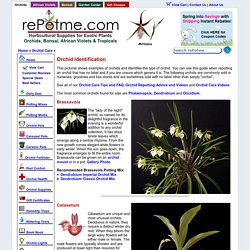
You can use this guide when repotting an orchid that has no label and if you are unsure which genera it is. The following orchids are commonly sold in nurseries, groceries and box stores and are sometimes sold with no label other than simply "orchid". See all of our Orchid Care Tips and FAQ, Orchid Repotting Advice and Videos and Orchid Care Videos. The most common orchids found for sale are Phalaenopsis, Dendrobium and Oncidium. 31 Plants That Repel Mosquitoes. When spring arrives so do those annoying mosquitoes.
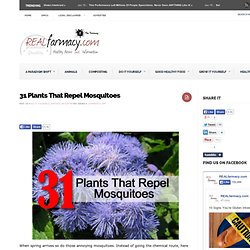
Instead of going the chemical route, here is a collection of mosquito repelling plants to make mosquito control more natural. Basil – Ocimum americanum – has essential oils that can be extracted and used as a spray to repel mosquitoes. It has also been an effective repellent when grown nearby. Bee Balm – Monarda – is a beautiful flowering plant that attracts hummingbirds and, of course, bees.
It is also very effective used as a mosquito repellent, when allowing the fragrant oils to be released when the leaves are crushed. Cadaga Tree – Eucalyptus torelliana – can repel mosquitoes simply by being planted in an area where mosquitoes are not wanted. Best air-filtering houseplants, according to NASA. Advice for getting into succulents. The Pancake Plant is Kalanchoe luciae, but there is another species ...
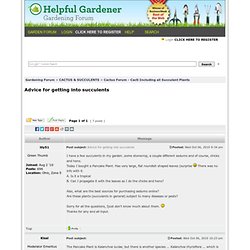
Kalanchoe thyrsiflora ... which is almost identical. The former will have reddish leaves when the weather is cool if grown in bright light. The latter species does not develop the red color. They are desert succulents, originating in Africa, not technically what one would classify as "tropical", IMO. They need extremely well-draining soil. Care is the same as for other Kalanchoes, and yes, they can be propagated from leaves or cuttings. Most succulents aren't bothered by many pests. K. luciae K. thrysflora _________________"Isn't it enough to see that a garden is beautiful without having to believe that there are fairies at the bottom of it too? " Indoor Flapjack Plant Care. The flapjack plant (Kalanchoe thyrsiflora) is known by many names, including the paddle plant, desert cabbage and the dog tongue plant.
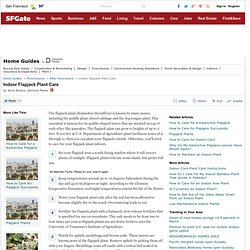
This succulent is famous for its paddle-shaped leaves that are stacked on top of each other like pancakes. The flapjack plant can grow to heights of up to 2 feet. If you live in U.S. Department of Agriculture plant hardiness zones of 9 through 11, then you can plant your flapjack outside. Otherwise, you'll need to care for your flapjack plant indoors. Set your flapjack near a south-facing window where it will receive plenty of sunlight. Keep temperatures around 50 to 70 degrees Fahrenheit during the day and 45 to 65 degrees at night. Water your flapjack plant only after the soil has been allowed to become slightly dry to the touch.
Fertilize the flapjack plant with a balanced, slow-release fertilizer that is specified for use on succulents. Watch for aphids, mealybugs and brown scale. Things You Will Need Tip Warning About the Author Have Feedback? How To Start A Monarch Butterfly Garden. If you’re thinking about starting a monarch butterfly garden, 2014 is the year to bring home the butterflies so we can bring back the monarchs…not only for ourselves, but for future generations in danger of losing the majestic monarch migration.
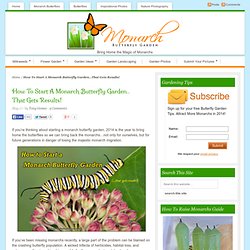
If you’ve been missing monarchs recently, a large part of the problem can be blamed on the crashing butterfly population. A wicked trifecta of herbicides, habitat loss, and extreme weather is making it impossible for the monarchs to catch a break. But every new monarch butterfly garden that emerges can have a positive impact on their struggling population. I’m sure you’ve heard the saying the first step is always the hardest. I think it’s especially true when you’re not sure where to begin. But even if you’ve already made unfortunate decisions creating your garden, it’s never to late to assess your situation, and make a course correction that will guide more butterflies into your garden.
Assess Your Situation. Why Don't You Try This?: 10 Best Plants to Grow Indoors for Air Purification. Most are naturally drawn to the outdoors for a period of quiet contemplation and/or a restful area to relax in.

But often snowy weather, lack of time, or location can inhibit one’s time in the wilderness. Thankfully, it is easier than ever to introduce flora into one’s home. Plants grown indoors have a variety of benefits. Not only are they the ultimate in functional decorating, but some well-placed greenery can brighten a space, purify the air, and also create a more relaxing, restful ambiance. Studies have also proven that bringing lush greenery indoors can help reduce stress levels, relieve tension, and even help one heal faster. 41882-mossgarden.